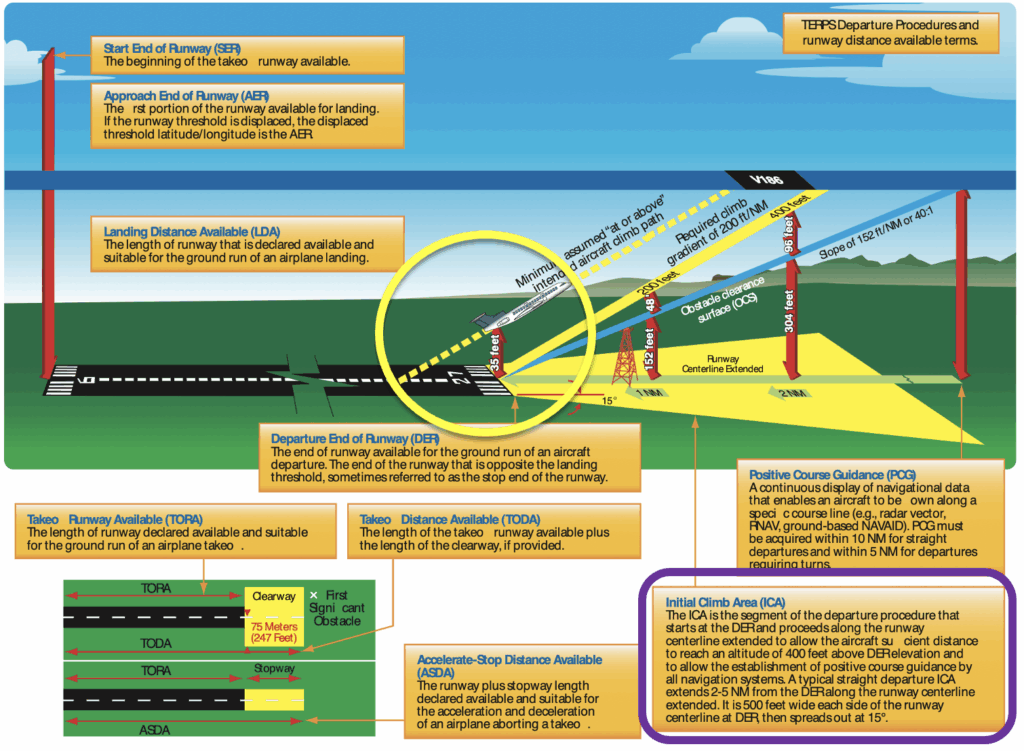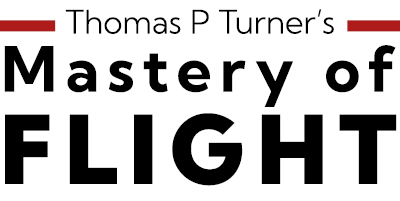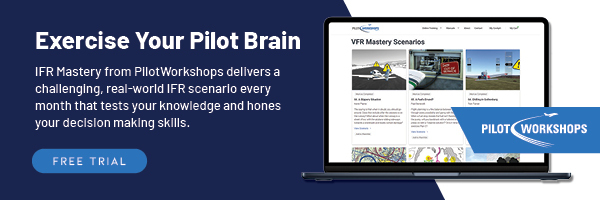This week’s topics include: > Three webinars > Finding TOD > At least

FLYING LESSONS uses recent mishap reports to consider what might have contributed to accidents, so you can make better decisions if you face similar circumstances. In most cases design characteristics of a specific airplane have little direct bearing on the possible causes of aircraft accidents—but knowing how your airplane’s systems respond can make the difference in your success as the scenario unfolds. So apply these FLYING LESSONS to the specific airplane you fly. Verify all technical information before applying it to your aircraft or operation, with manufacturers’ data and recommendations taking precedence. You are pilot in command and are ultimately responsible for the decisions you make.
FLYING LESSONS is an independent product of MASTERY FLIGHT TRAINING, INC.
Pursue Mastery of Flight®
This week’s LESSONS:
I’ve recorded several webinars with the Experimental Aircraft Association on real-world instrument flying skills beyond what’s commonly taught in IFR flight test preparation, including:
IFR Departures- From Planning to the En Route Environment:
Instrument training, proficiency, and currency requirements are built primarily around instrument approaches. But getting from the airport to the enroute environment under instrument flight rules is equally as complex and requiring of study, training, and practice of the following: • Obstacle Departure Procedures (ODPs) • Standard Instrument Departures (SIDs) • Visual Climb Over Airport (VCOA) procedures • Departing VFR to pick up your clearance in the air • Abnormal and emergency procedures during an IFR departure • Maintaining currency and proficiency in IFR departure procedures • Answers to viewer questions.
IFR Routing Tricks for Efficiency and Workload Reduction, reviewing:
Ideas for planning and executing IFR flights using non-towered airports, into and out of high-density airspace using SIDs and STARs, when it’s a good idea to pick up a clearance in the air and when it’s not, and special techniques for making short-distance flights in instrument meteorological conditions, answers to viewer questions and more
…and most recently, From Cruise to the Initial Approach Fix, highlighting:
Instrument training, proficiency, and currency requirements are primarily about instrument approaches. This webinar will help you by covering: Adjusting your checklists to reduce workload during descent and approach. STARs for the piston and single-pilot turbine crowd. Speed, power, and trim in descent. Techniques for an easy letdown. IFR letdowns into nontowered airports. Real-world holding patterns and vectors for spacing. Traffic avoidance in IFR descents into VMC or marginal VFR. Confirming everything is set before you reach the final approach fix. Answers to viewer questions.
Thank you, EAA, for asking me to be part of your work to improve flying safety.
Questions? Comments? Supportable opinions? Let us know at [email protected].
Debrief
Readers write about recent LESSONS:
After viewing my webinar Cruise to IAF FLYING LESSONS reader Edwin Trautman wrote:
One area I would like to see get some attention is descent planning. Where should you plan the TOD [top of descent]? Letting ATC do it for you can be problematic. They do a good job most of the time and certainly have their own plans. In the North East that means getting down early (bad for turbines). I usually plan on a 3-degree descent which for me is about 1000-1200 fpm. With a strong tailwind I have to pull way back and rather try to head down sooner. Other turboprop pilots descend at 1500 fpm. There is no specific guidance in the AIM [Airman Information Manual] or FAR [Federal Air Regulations]. What guidance should we give?
The vast majority of my experience is in unpressurized piston airplanes. In those types I like to descend at 500 feet per minute while maintaining my cruise indicated airspeed—making good forward speed. If I’m going to be able to make a constant descent from cruise to approach or pattern altitude, I’ll multiply the difference in thousands of feet between that altitude and my cruise altitude by two and begin my descent that number in minutes from the fix at which I want to be at that altitude. It’s easier than it sounds:
- If I’m at 9000 feet and the pattern altitude at my destination is 2200 feet, I’ll descend approximately 7000 feet. It’ll take about 14 minutes to descend, so I’ll watch my GPS to see when I’m 15 miles out and ask ATC for a descent if they’ve not granted one already.
- If I’m at 17,000 feet and need to descend to 3500 feet I’ll descend 13,500 feet. I’ll need to plan my TOD about 26 minutes out.
In turbine equipment you might do the same thing at whatever you consider to be a good rate of descent. At 1500 fpm, for example, begin descent about nine minutes from the fix at which you need to be at the lower altitude. Alternately you can slow your forward speed to descend at a steeper angle at the same vertical speed.
Of course there are more sophisticated ways to plan your TOD. Readers (turbine and piston), what do you do?
Ed continues:
A related issue is being left high and then “cleared for the approach”, particularly on a visual approach as you wait to see the airport. What guidance should we give here?
That’s when I slow down, even use partial flaps and (in extreme cases) extended landing gear to come down at a steeper angle. Other ideas, readers? Thank you, Ed.
Larry Levin asked about one example I used on use of Terminal Arrival Altitude (TAA):
In the RNAV 18 approach to KAAO, if you are exactly on the 271 bearing to HENEV/HUKAM, would you descend to 4100 or 3600 when within 30 miles. That is the border of two sectors.

Good question. I’ve not found any specific guidance. Given that if cleared for the approach more than 30 miles out I’d descend to the higher altitude, 4100 MSL, when 30 nm from Hukam, then descend to 3600 when 25 nm from the fix. I’m open to supported interpretations otherwise if someone out there knows.
A reader who asks to remain anonymous asks:
I re-listened to your webinar on From Planning to the Enroute Environment. I have a question about when to turn on an instrument departure from a long runway. For example, the ODP [Obstacle Departure Procedure] for Rwys 34L/R at KPAE (Everett, Washington) initially calls for a climbing left turn. The runway is 9,000 [feet long]. In a Cessna 172 do I fly to the DER [Departure End of the Runway] where I’ll be well above 400 feet [AGL] before beginning my turn, or do I begin my turn when I’m approximately 400 feet AGL? I can’t seem to find the answer in the regulations, etc. I might have missed it in your webinar. A bottom line is: what does ATC expect of me if they have not issued any specific turn instructions?
Chapter 1 of the FAA Instrument Procedures Handbook (IPH) includes figure 1-16, shown below with my annotations:

My yellow circle on the figure shows the criterion for crossing the DER. The aircraft must be (at least) 35 feet above DER height to meet obstacle clearance and climb gradient requirements. The figure’s dashed yellow line (within my circle) shows a minimum “at or above” climb path.
I also outlined, in purple, the description of Initial Climb Area (ICA). This assumes the airplane will be at least 400 feet above DER elevation “to allow the establishment of positive course guidance by all navigation systems.” The ICA extends well beyond the end of the runway in case the airplane needs it, but it does not require the aircraft to remain on runway heading to the end of the runway. In other words, climb to 400 AGL and then turn on course, whether or not you have passed the end of the runway. That’s what controllers should expect you to do. Thanks, anonymous.
More to say? Let us learn from you, at [email protected]

Share safer skies. Forward FLYING LESSONS to a friend.
Please help cover the ongoing costs of providing FLYING LESSONS through this secure PayPal donations link. Or send a check made out to Mastery Flight Training, Inc. at 247 Tiffany Street, Rose Hill, Kansas USA 67133. Thank you, generous supporters.
Thank you to our regular monthly financial contributors:
Steven Bernstein, Montclair, NJ. Robert Carhart, Jr., Odentown, MD. Greg Cohen, Gaithersburg, MD. John Collins, Martinsburg, WV. Dan Drew. Rob Finfrock, Rio Rancho, NM. Norman Gallagher. Bill Griffith, Indianapolis, IN. Steven Hefner, Corinth, MS; Ellen Herr, Ft Myers, FL. Erik Hoel, Redlands, CA. Ron Horton. David Karalunas, Anchorage, AK. Steve Kelly, Appleton, WI. Karl Kleiderer. Greg Long, Johnston, IA. Rick Lugash, Los Angeles, CA. Richard McCraw, Hinesburg, VT. David Ovad, Resiertown, MD. Steven Oxholm, Portsmouth, NH. Brian Schiff, Keller, TX. Paul Sergeant, Allen, TX. Paul Uhlig, Wichita, KS. Richard Whitney, Warrenton, VA. Jim Preston, Alexandria, VA. Johannes Ascherl, Munich, Germany. Bruce Dickerson, Asheville, NC. Edmund Braly, Norman, OK. Steven Hefner. Lorne Sheren, New Vernon, NJ. “The Proficient Pilot,” Keller, TX. Ed Stack, Prospect Heights, IL. Kynan Sturgiss, Hereford, TX. Bluegrass Rental Properties, LLC, London, KY. John Foster. Joseph Victor, Bellevue, WA. Chris Palmer, Irvine, CA. Barry Warner, Yakima, WA. Todd LeClair, Cadiz, KY. Jim Hopp, San Carlos, CA. Adrian Chapman, West Chester, PA
Thanks also to these donors in 2025:
John Teipen. N. Wendell Todd. David Peterson. Jay Apt. SABRIS Aviation/Dave Dewhirst. Gilbert Buettner. David Larsen, Peter Baron, Glen Yeldezian, Charles Waldrop, Ian O’Connell, Mark Sletten, Lucius Fleuchaus. Thomas Jaszewski. Lauren McGavran. Bruce Jacobsen, Leroy Atkins, Coyle Schwab, Michael Morrow, Lew Gage, Panatech Computer (Henry Fiorentini), John Whitehead, Andy Urban, Wayne Colburn, Stu Spindel, Dave Buetow, Ken Vernmar, Dave Wacker, Bill Farrell, David Miller, Daniel Norris, Robert Sparks, Bill Cannon
Pursue Mastery of Flight®
Thomas P. Turner, M.S. Aviation Safety
Flight Instructor Hall of Fame Inductee
2021 Jack Eggspuehler Service Award winner
2010 National FAA Safety Team Representative of the Year
2008 FAA Central Region CFI of the Year
FLYING LESSONS is ©2025 Mastery Flight Training, Inc. For more information see www.thomaspturner.com. For reprint permission or other questions contact [email protected]


